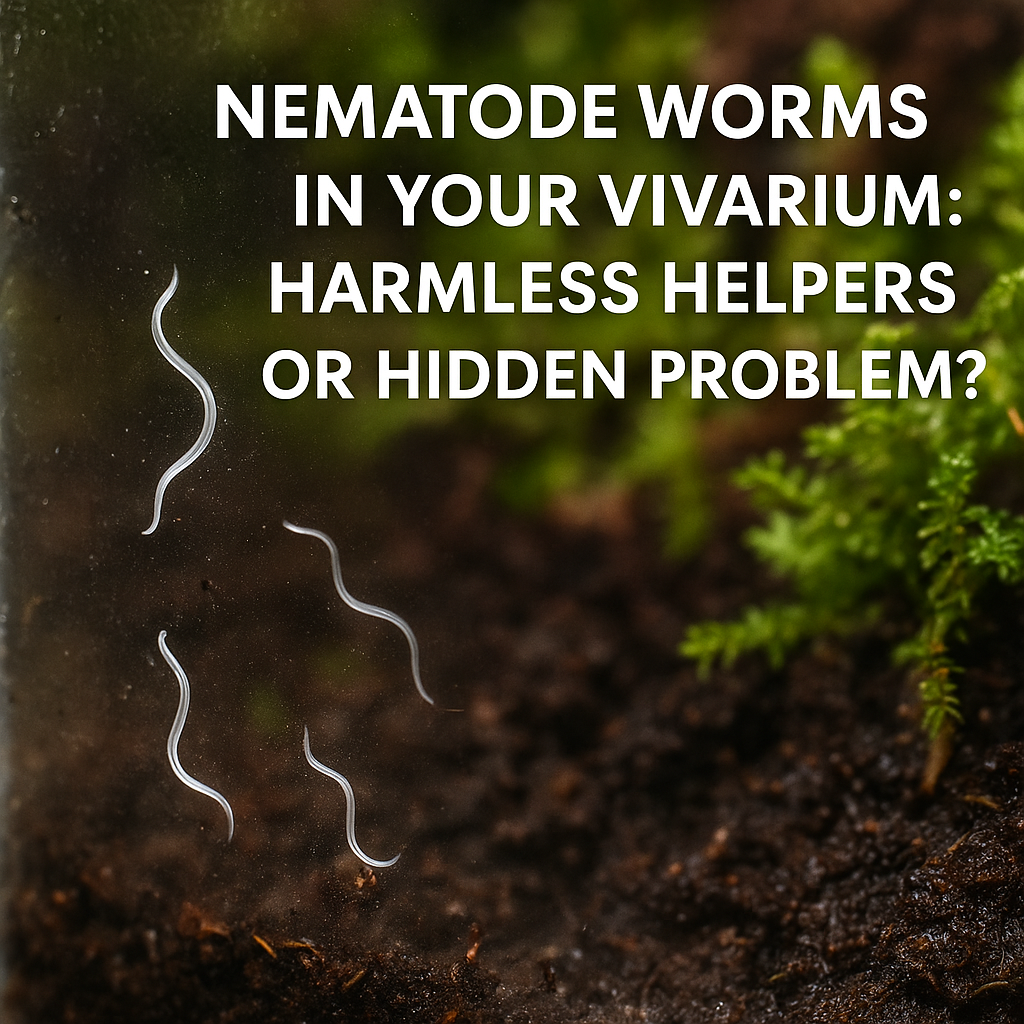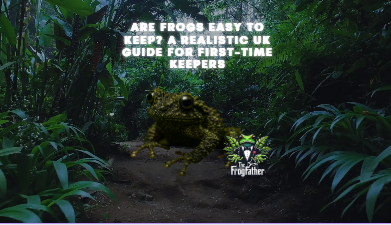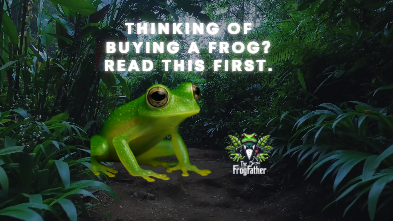You’re misting your vivarium when you notice something strange — tiny, threadlike worms wriggling across the glass or moving through the substrate. Your first thought might be, “What on earth are those? Are they parasites?”
Don’t panic. You’ve just discovered nematodes — one of the most misunderstood organisms in the bioactive world. They’re microscopic to a few millimetres long, and they often appear when your setup has matured enough to support an invisible web of soil life. But are they good or bad? Should you try to get rid of them? And can they harm your frogs, plants, or eggs?
Let’s dig into what’s really going on beneath the surface.
🌱 What Are Nematodes, Exactly?
Nematodes are microscopic roundworms — part of an enormous group of soil organisms that exist in almost every environment on Earth. In fact, scientists estimate that four out of every five animals on the planet are nematodes!
In a bioactive vivarium, they’re not something that’s been “infested” — they’re simply part of your natural microfauna community. Just like springtails, mites, and isopods, some nematodes break down waste, others feed on bacteria or decaying matter, and a few species can become problematic under certain conditions.
So, seeing nematodes doesn’t automatically mean trouble — it just means your ecosystem is alive and busy.
🪲 How Do Nematodes Get Into a Vivarium?
They’re almost impossible to avoid. Nematodes can enter your setup through several completely normal routes:
- 🌿 Plants: Soil, roots, and moss from garden centres or suppliers often carry harmless soil nematodes.
- 🪴 Substrate ingredients: Leaf litter, compost, and coco fibre can contain nematode eggs or cysts.
- 🧺 Microfauna cultures: Springtail or isopod starter cultures often include nematodes naturally.
- 💧 Moisture & air: They’re so small they can travel on mist, air, or even your hands during maintenance.
So, if you’ve spotted a few wriggling lines on your glass or in your substrate — don’t worry, it’s completely normal.
⚖️ Are All Nematodes the Same?
Not at all. There are thousands of different nematode species, and they fall roughly into three categories:
- Free-living (beneficial) nematodes – These feed on bacteria, algae, and decaying organic matter. They help break down waste and keep your soil healthy.
- Plant-feeding nematodes – Some species attack plant roots, but these are extremely rare in enclosed bioactive setups.
- Parasitic nematodes – A tiny fraction of species can parasitise insects, snails, or amphibians, but again, this is very uncommon in captive vivariums that use sterile or commercially prepared materials.
The vast majority of nematodes you’ll ever see in a vivarium are harmless detritivores helping to process waste — just part of your natural clean-up crew.
🐸 Are Nematodes Dangerous to Frogs?
This is the big question most people ask — and it’s a reasonable one.
Most nematodes in a vivarium are harmless and non-parasitic. They live in the top few millimetres of soil or on damp glass, feeding on bacteria and decomposing matter. Dart frogs and other amphibians may occasionally ingest them while hunting microfauna, but that’s not harmful.
However, there are a few important distinctions:
- Free-living nematodes (the kind you can see on glass or soil) are harmless.
- Parasitic nematodes (internal worms like *Rhabdias*) can infect amphibians — but these are completely different species that must be transmitted directly from an infected animal, not through soil or plants.
So if your frogs are healthy, eating, and showing no symptoms, the nematodes you’re seeing are simply soil dwellers — not parasites.
🐣 Can Nematodes Harm Frog Eggs or Tadpoles?
Occasionally, you may see nematodes near egg clutches or in standing water. Most are harmless detritivores feeding on biofilm and waste. However, in poorly ventilated or stagnant conditions, they can multiply rapidly and irritate delicate frog eggs.
If you’re breeding frogs, it’s best to move eggs or tadpoles to a clean rearing tub with fresh water and avoid transferring substrate. Nematodes can’t survive long in clean, aerated water, so they’ll die off naturally.
🌿 Can They Harm Plants?
Most nematodes in vivariums are neutral or even beneficial to plants, breaking down organic matter into nutrients. Plant-parasitic nematodes that attack roots are rare and almost never occur in enclosed terrariums.
If your plants show no yellowing or root rot, nematodes aren’t to blame — it’s far more likely to be overwatering or compaction.
🧬 The Pros of Having Nematodes
Believe it or not, nematodes offer some great benefits when present in moderate numbers:
- They improve substrate health by eating bacteria and decaying material.
- They help prevent anaerobic pockets that can lead to foul smells or rot.
- They serve as a natural food source for some microfauna and small invertebrates.
- They indicate your ecosystem is active and mature.
Think of nematodes as part of your vivarium’s soil microbiome — invisible workers keeping the system cycling smoothly.
⚠️ The Cons (and When They Become a Problem)
While harmless in small numbers, nematodes can become a nuisance if they multiply excessively, usually because of:
- Overfeeding (excess fruit flies or uneaten food)
- Constantly soggy substrate with poor ventilation
- Dead plant roots or organic build-up
- Low microfauna diversity (not enough springtails/isopods to compete)
When populations boom, you might see thin white worms crawling up the glass or even on décor. This doesn’t mean your tank is “infected” — just temporarily out of balance.
🧹 How to Reduce or Remove Nematodes
You usually don’t need to remove them entirely — just bring the ecosystem back into balance. Try these natural steps:
- Cut back on feeding: Remove uneaten food promptly to limit bacterial growth that nematodes feed on.
- Increase airflow: Open vents or use a vented vivarium to reduce stagnant moisture.
- Encourage microfauna competition: Add a culture of springtails or isopods — they’ll naturally compete with nematodes for food.
- Clean the glass: Use a microfibre cloth or citric acid solution to remove visible worms; this reduces their spreading surfaces.
- Let the substrate dry slightly: Nematodes thrive in oversaturated soil — allow brief drying periods between misting.
- Spot refresh substrate: Replace a small section of substrate if infestation seems heavy, rather than tearing down the whole tank.
Within a week or two, nematode numbers usually drop back to normal on their own.
🧼 When to Consider a Reset
Full resets are rarely necessary. But if you’re noticing foul odours, consistently wet substrate, or dead plant roots, you may want to replace a portion of the soil layer and refresh microfauna colonies. Combine this with proper ventilation, and the nematode issue won’t return.
🌾 How to Prevent Nematode Surges
Prevention mostly comes down to good husbandry:
- Quarantine new plants (see our plant quarantine guide).
- Don’t overfeed — remove old fruit flies or feeder remains daily.
- Keep air moving gently — condensation should clear between mistings.
- Regularly seed springtails to maintain a healthy microfauna balance.
🧠 Final Thoughts
Finding nematodes in your vivarium isn’t a sign of failure — it’s proof that your setup has developed its own ecosystem. In most cases, these microscopic worms are just part of your natural soil life, quietly recycling nutrients and keeping your substrate healthy.
Unless your vivarium is visibly overrun or showing signs of imbalance, there’s no need to panic or tear everything down. Simply adjust feeding, airflow, and moisture, and nature will handle the rest.
Remember — in a living vivarium, balance is everything. A few tiny worms are just another reminder that your little rainforest is doing exactly what it should.
❓ Frequently Asked Questions
I’ve found tiny white worms in my vivarium — what are they?
They’re usually free-living nematodes (microscopic roundworms) or sometimes enchytraeids (also called potworms). Both are common in healthy, damp soil and feed on bacteria and decaying material.
How did nematodes get into my vivarium?
They hitchhike in on plants, substrate, leaf litter, moss or microfauna cultures. Their eggs or cysts are tiny and spread easily in moist environments — this is normal for bioactive setups.
Are nematodes harmful to dart frogs?
Free-living soil nematodes are not harmful to frogs. They live in the top soil layer and on moist glass feeding on biofilm and waste. Harmful parasitic nematodes are different species and require transmission from an infected animal.
Can they hurt frog eggs or tadpoles?
In most cases, no. In stagnant, poorly ventilated conditions they can multiply around eggs and become an irritant. If you’re breeding, move eggs/tadpoles to a clean rearing tub with fresh, aerated water.
Will nematodes damage my plants?
Very unlikely. The species that appear in vivariums are typically detritivores and can even benefit substrate health. True plant-parasitic nematodes are rare in enclosed terrariums.
What’s the difference between nematodes and potworms?
Nematodes are hair-thin, threadlike, and move with a quick, S-shaped wiggle. Potworms (enchytraeids) are small, white annelid worms — slightly thicker, segmented, and slower. Both are usually harmless soil recyclers.
Should I remove nematodes from my vivarium?
You rarely need to. If numbers boom or you see them all over the glass, rebalance the setup: reduce feeding, increase airflow, let the top layer dry slightly, and bolster springtails to compete.
How do I reduce a nematode bloom naturally?
1) Remove uneaten food, 2) open vents or use a vented vivarium, 3) wipe visible worms from glass, 4) allow brief drying between mists, 5) spot-refresh a small area of substrate if needed.
Are chemical treatments safe?
No. Avoid pesticides or wormers in a bioactive enclosure — they can harm frogs and microfauna. Natural husbandry tweaks are safer and effective.
How do I prevent them building up again?
Quarantine plants, avoid overfeeding, maintain gentle airflow (condensation should clear between mistings), and periodically seed springtails to keep the soil food web balanced.



